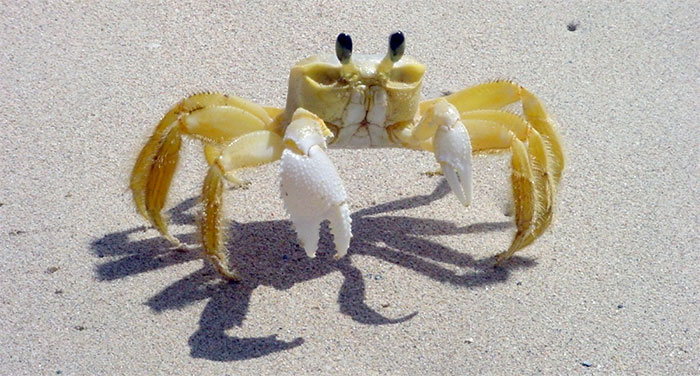Ghost crabs use teeth in their stomach to intimidate enemies
When threatened, Atlantic ghost crabs can make a loud growl with the teeth that evolved to shred food.
The researchers used lasers and X-rays to determine where the noise came from within the crab's body and discovered the crusher itself. When you want to attack or need to hold territory, ghosts can make sounds by rubbing claws. However, they can also raise as much threat and at the same time raise a threatening call from the abdomen during clashes to protect the cave or food.

The threatening growl of the crab from the gastric mill, the teeth located in the front of the crab.
To find out how they do this, marine biologist Jennifer Taylor at the University of California, San Diego and her colleagues studied 30 Atlantic crabs (Ocypode quadrata) in the lab. The scientists use Doppler ultrasonic laser technology, which allows vibration measurement by reflected laser light.
After identifying the sound coming from the crab's digestive system, the team took an X-ray to learn how the sound was made. They found the sound came from the gastric mill , the teeth located in the front of the crab. The Gastric mill consists of horizontal teeth with multiple teeth such as the comb teeth that can be rubbed against the middle teeth of the food processor, helping to produce sounds below 2 kHz.
According to the team, animals rarely develop two independent mechanisms to create similar sounds for the purpose of self-defense. However, the texture of the abdomen frees the pincers so that the crab can pique and show aggression. The results are published in Proceedings of the Royal Society B: Biological Sciences.
- How to eat crabs?
- Catching super rare purple crabs caused a stir
- Chewing gum for more than 10 minutes badly affects your teeth and stomach
- Top of unprecedented species of crabs
- Giant sea crabs with fishermen nets
- Video: Hold 1,000 crabs in the palm of your hand
- Create the stomach in the world's first laboratory
- Giant crabs weigh up to 4kg
- Video: Sea slug boss stomach eating raw hermit crab
- Why do crocodiles swallow stones in the stomach?
- How to choose crabs, delicious and meaty crabs
- Australia: Red crabs are in danger because of oil spills
 Surprised: Fish that live in the dark ocean still see colors
Surprised: Fish that live in the dark ocean still see colors Japan suddenly caught the creature that caused the earthquake in the legend
Japan suddenly caught the creature that caused the earthquake in the legend A series of gray whale carcasses washed ashore on California's coast
A series of gray whale carcasses washed ashore on California's coast Compare the size of shark species in the world
Compare the size of shark species in the world